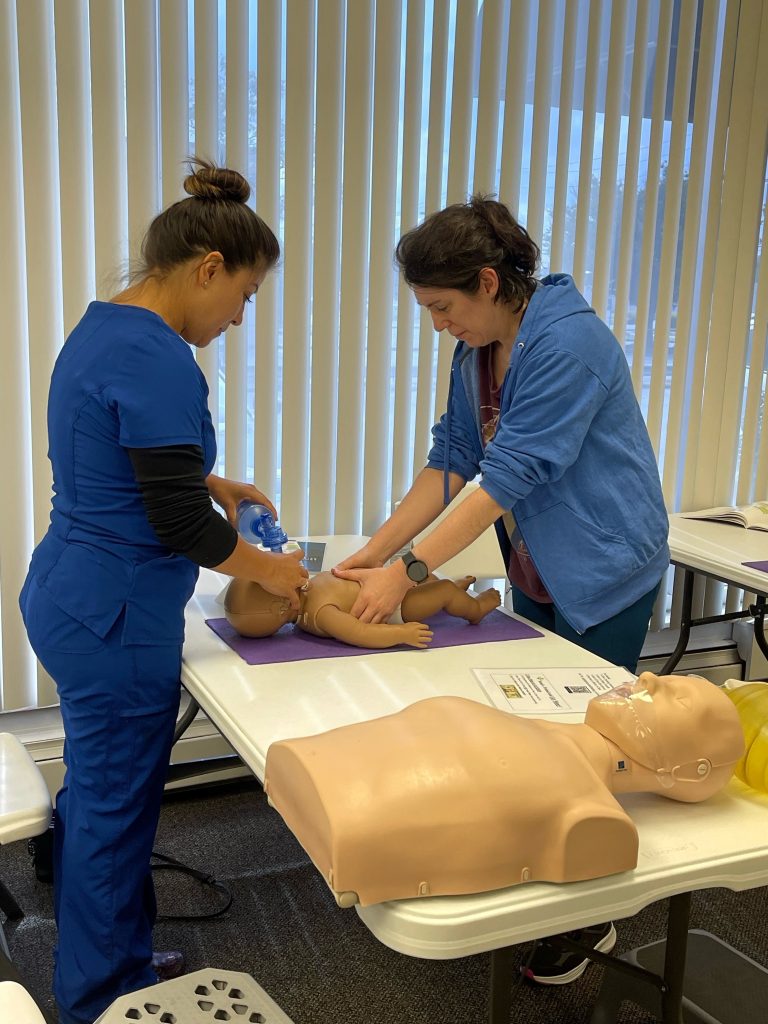When cardiac arrest strikes, every second counts. Two-rescuer cardiopulmonary resuscitation (CPR) offers significant advantages over single-rescuer techniques, particularly in delivering consistent, high-quality chest compressions that can dramatically improve survival outcomes. This article explores evidence-based strategies for maximizing the effectiveness of chest compressions in two-rescuer CPR scenarios, equipping both healthcare professionals and laypersons with the knowledge needed to respond confidently during cardiac emergencies.
Understanding the Critical Role of Two-Rescuer CPR: Chest Compressions
The American Heart Association (AHA) emphasizes that high-quality chest compressions form the foundation of effective CPR. When performed correctly, chest compressions generate blood flow to vital organs, delivering oxygen and removing waste products. This circulatory support buys precious time until advanced medical interventions can be implemented or spontaneous circulation returns.
Two-rescuer CPR offers distinct advantages over single-rescuer techniques. With two trained individuals working together, one can focus exclusively on delivering optimal chest compressions while the other manages ventilations and monitors the overall response. This division of responsibilities helps prevent rescuer fatigue, a significant factor that diminishes compression quality during prolonged resuscitation efforts.
Research published in the Journal of Emergency Medicine demonstrates that two-rescuer CPR produces superior compression depth, rate consistency, and fewer interruptions compared to single-rescuer methods. These improvements directly correlate with better survival rates and neurological outcomes following cardiac arrest.
Key Components of High-Quality Two-Rescuer CPR: Chest Compressions
Proper Positioning for Two-Rescuer CPR: Chest Compressions
Effective chest compressions begin with proper positioning. The patient should be placed on a firm, flat surface to maximize compression effectiveness. In two-rescuer scenarios, rescuers should position themselves on opposite sides of the patient when possible—one designated for compressions and the other for airway management and ventilation.
The compression rescuer should:
- Kneel beside the patient’s chest
- Ensure their shoulders are directly over their hands
- Keep arms straight with elbows locked
- Position hands on the lower half of the sternum (breastbone)
This positioning maximizes the downward force while minimizing rescuer fatigue, enabling delivery of the recommended compression depth of 2-2.4 inches (5-6 cm) for adults.
Compression Rate and Rhythm in Two-Rescuer CPR
The AHA recommends a compression rate of 100-120 per minute—a pace that balances the need for adequate cardiac output with complete chest recoil between compressions. To maintain this rhythm in two-rescuer CPR, many professionals use the beat of songs like “Stayin’ Alive” by the Bee Gees or “Dancing Queen” by ABBA, both of which have approximately 100 beats per minute.
The compression-to-ventilation ratio in two-rescuer CPR is 30:2 for adults without advanced airways. Once an advanced airway is placed, rescuers transition to continuous compressions while ventilations are delivered at a rate of one breath every 6 seconds (10 breaths per minute).
Minimizing Interruptions During Two-Rescuer CPR: Chest Compressions
Chest compression interruptions significantly impact survival outcomes. Studies show that each 5-second pause in compressions results in a measurable drop in coronary perfusion pressure, which takes multiple compressions to rebuild. In two-rescuer CPR, the goal is to limit interruptions to less than 10 seconds for essential activities like pulse checks, defibrillation, or rescuer switches.
The coordination between rescuers becomes critical here. When switching positions—recommended every 2 minutes to prevent fatigue—the transition should be swift and seamless. The ventilation rescuer should be prepared to take over compressions immediately while communicating the switch with phrases like “I’m taking over compressions on three: one, two, three.”
Advanced Techniques for Two-Rescuer CPR: Chest Compressions
Compression Feedback Devices
Technology has revolutionized resuscitation training and performance. Compression feedback devices provide real-time guidance on compression depth, rate, and recoil. These tools range from simple metronomes that maintain pace to sophisticated sensors that display compression metrics on monitors.
In a two-rescuer scenario, the non-compressing rescuer can monitor feedback data and provide coaching to optimize performance. Research from the Resuscitation journal indicates that teams using feedback devices deliver compressions with 22% better depth consistency and 14% more accurate rates than those without guidance.
Team Communication During Two-Rescuer CPR: Chest Compressions
Clear, concise communication forms the backbone of effective two-rescuer CPR. Closed-loop communication—where instructions are acknowledged and confirmed—prevents misunderstandings during high-stress situations.
The compression rescuer should count compressions aloud in sets of ten, enabling both rescuers to maintain rhythm and anticipate ventilation breaks. The ventilation rescuer should verbally confirm after delivering breaths with a simple “breaths delivered” before compressions resume.
Studies from the International Journal of Emergency Medicine demonstrate that teams using structured communication protocols experience 40% fewer errors and 27% shorter compression interruptions compared to teams without established communication patterns.
Common Challenges in Two-Rescuer CPR: Chest Compressions
Rescuer Fatigue Management
Despite the advantage of having two rescuers, fatigue remains a significant challenge during prolonged resuscitation efforts. Physical exhaustion can set in as quickly as 1-2 minutes after beginning compressions, gradually degrading compression quality even when rescuers believe they’re maintaining standards.
Effective fatigue management in two-rescuer CPR includes:
- Switching roles every 2 minutes or approximately 5 cycles of 30:2
- Using proper body mechanics (straight arms, shoulders over hands)
- Verbalizing when fatigue begins affecting performance
- Planning switch timing to coincide with other necessary interruptions
Some emergency response teams now implement three or more rescuers when available, creating a rotation system that further reduces fatigue-related quality degradation.
Special Considerations for Different Patient Populations
Two-rescuer CPR techniques require modification based on patient characteristics:
For pediatric patients (1 year to puberty):
- Compress to a depth of approximately one-third the chest diameter (about 2 inches)
- Maintain a 15:2 compression-to-ventilation ratio in two-rescuer scenarios
- Use one or two hands, depending on the child’s size and the rescuer’s strength
For infant patients (under 1 year):
- Use a two-finger or two-thumb encircling technique for compressions
- Compress to a depth of approximately one-third the chest diameter (about 1.5 inches)
- Maintain a 15:2 compression-to-ventilation ratio in two-rescuer scenarios
For pregnant patients:
- Position the patient with a left lateral tilt (or manually displace the uterus)
- Adjust hand position slightly higher on the sternum
- Consider early transition to advanced life support protocols
Training and Certification for Two-Rescuer CPR: Chest Compressions
Regular training and certification are essential for maintaining two-rescuer CPR proficiency. The AHA recommends recertification every two years, though more frequent refresher training yields better skill retention. Simulation-based training that incorporates realistic scenarios with two-rescuer dynamics has proven particularly effective in building team coordination.
Modern CPR training emphasizes high-quality compressions through deliberate practice with feedback. Instructors focus on helping students develop muscle memory for proper technique while building the stamina needed for effective resuscitation.
Research published in the American Journal of Emergency Medicine indicates that rescuers who participate in quarterly refresher training maintain significantly higher compression quality than those who train only at two-year intervals.
Integrating Two-Rescuer CPR: Chest Compressions with Automated External Defibrillators (AEDs)
The combination of high-quality CPR and early defibrillation provides the best chance for survival from sudden cardiac arrest. In two-rescuer scenarios with an AED available, roles should be established:
- The first rescuer begins chest compressions immediately
- The second rescuer retrieves and prepares the AED
- Compressions continue until the AED is ready for analysis
- Clear communication during the analysis/shock sequence minimizes interruptions
After a shock is delivered, chest compressions should resume immediately without delay for pulse checks. The two-rescuer team should rotate positions every 2 minutes, typically coinciding with AED rhythm checks.
The Future of Two-Rescuer CPR: Chest Compressions
Resuscitation science continues to evolve, with emerging technologies and techniques promising to further improve two-rescuer CPR outcomes. Current research areas include:
- Mechanical compression devices that deliver consistent, precise compressions
- Physiological feedback systems that adjust compression parameters based on patient response
- Virtual reality training that simulates partner coordination in two-rescuer scenarios
- Mobile applications that guide rescuer timing and technique during real emergencies
While technology advances, the fundamentals remain unchanged: early recognition, immediate high-quality CPR, rapid defibrillation, and effective post-resuscitation care form the chain of survival that gives cardiac arrest victims the best chance of recovery.
Conclusion
Two-rescuer CPR, when performed with high-quality chest compressions, significantly improves survival chances for cardiac arrest victims. By maintaining proper hand positioning, adhering to recommended rates and depths, minimizing interruptions, and communicating effectively, rescuers can maximize blood flow to vital organs during this critical emergency.
The coordination between two trained rescuers allows for sustained high-performance CPR that single-rescuer techniques simply cannot match. When combined with early defibrillation and advanced life support, optimal two-rescuer CPR forms the cornerstone of modern resuscitation protocols.
Your Next Steps to CPR Mastery
Are you ready to develop the skills needed to perform life-saving two-rescuer CPR? CPR Columbus offers comprehensive American Heart Association training in CPR certification in Columbus. Our stress-free, hands-on classes provide the practice and confidence needed to respond effectively during cardiac emergencies.
Whether you’re a healthcare professional requiring BLS certification in Columbus or a community member seeking CPR certification in Columbus, our experienced instructors will guide you through the latest techniques in high-quality chest compressions and effective two-rescuer coordination.
Don’t wait until an emergency strikes to prepare. Contact the best CPR in Columbus today to schedule your training session and join the ranks of those ready to save lives when minutes matter most.





